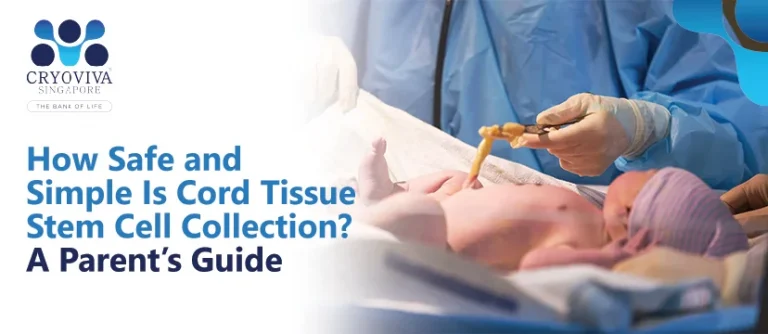Blog
How Safe and Simple Is Cord Tissue Stem Cell Collection? A Parent’s Guide

There might be multiple moments or decision-making situations when you worry endlessly about something, only to discover that it turned out far better than you imagined. That’s exactly how many parents in Singapore feel when they first hear about the process of cord tissue stem cell collection or cord tissue banking at Cryoviva Singapore.
Yes, the thought of medical procedures can sound a bit complicated or even stressful. However, in reality, the collection is simple, safe, and completely painless for protection against potential future conditions. Read this blog to know how this small, gentle health investment can offer lasting protection against possible future conditions
What is a Cord Tissue Stem Cell?
A cord tissue stem cell (mesenchymal stem cell) is a potentially lifesaving cell found in the tissue of the umbilical cord. These stem cells have the unique ability to grow and develop into many different types of cells in the body, such as bone, muscle, or nerve cells.
They help to repair, replenish, and rejuvenate the damaged tissues and cells. Scientists are now exploring how they can be employed in medical treatments for injuries and diseases. Stem cell collection at birth may seem complex to you, but it is painless and done right after birth from the leftover umbilical cord tissue.
The Cord Tissue Stem Cell Collection Process in Singapore | Safe & Simple
Stem cell banking from cord tissue has the following safe and simple procedure:
Right After Baby’s Delivery
Right after the delivery, the umbilical cord is clamped and cut. This step is completely safe and painless for both mother and baby.
Cord Tissue Collection By a Professional
A professional from Cryoviva Singapore carefully collects a small segment (usually about 10-15 cm long) of the leftover cord tissue (not the cord blood). This step is done using sterile techniques.
Note that some parents opt for both cord tissue and cord blood stem cell collection. In this case, both tissue and blood are collected safely using sterile techniques.
Special Container Used For Packing
This collected cord tissue is placed in a secure, temperature-controlled container provided by the private cord blood or tissue bank. This helps keep the tissue fresh and safe until it reaches the assigned laboratory.
Note: Cryoviva Singapore has many laboratories and is strategically located in Central Singapore (Bishan)
Safely Transport to Assigned Lab
The collected tissue is quickly delivered to a specialized stem cell bank or laboratory. There is a team assigned for further processing, testing, and storage.
Processing & Cord Tissue Testing
In the laboratory, the cord tissue is disinfected and cleaned. The stem cells are carefully isolated, tested for infections, and prepared for long-term storage.
The common tests performed in the lab are:
- Cell viability test: To check if the cells are alive and healthy.
- Immunophenotyping: To confirm the right type of mesenchymal stem cells (MSCs)
- Trilineage differentiation test: To confirm if the cells have the ability to turn into different cell types.
- Sterility test: To check if the sample is free from bacteria, fungi, or other contaminants.
- Genetic testing: To check for any chromosomal abnormalities or infectious agents.
- Other tests: To know if there are any disease conditions, so that the cord tissue is safe for future use.
Note: Cryoviva Singapore provides the AXP Processing Bag Set with robust support during centrifugation (stem cell separation). This reduces processing time and is cost-effective, as it runs 6 devices in one centrifuge.
Cryopreservation (Freezing at −190 degrees Celsius)
The viable and right stem cells are separated from the cord tissue; they are then frozen at extremely low temperatures. This preserves their safety and quality for medical use (if required in the future).
Which Gas Is Used for Cryopreservation of Stem Cells?
For the storage step in cord tissue stem cell collection, Liquid nitrogen (LN2) is used for cryopreservation. You may ask, “Why is liquid nitrogen used?”
Because of its following benefits:
- Stops all biological activity.
- Preserves cells precisely for long-term storage.
- Prevents ice crystals from forming within cells, preventing damage to cell structure.
- It keeps stem cells viable and stable for years to come.
- It’s a standard in labs worldwide because of its reliability and effectiveness
Conclusion
Instead of fearing the process of stem cell preservation, you can choose to learn about the safe, simple collection. There are many success stories that inspire confidence, such as 6-year-old Harshita, who overcame Thalassemia Major with a matched stem cell transplant through Cryoviva India. Hence, don’t let your fear prevent you from opting out of a life-saving step.
Ready to safeguard your family’s futures? Then contact us now.
Our Address: Corporate Office, 37 Jalan Pemimpin, #01-06 Mapex, Singapore 577177.
FAQ's
- Costs vary based on the cord blood bank and selected services.
- Includes charges for collection, processing, and storage.
- Cryoviva Singapore offers private cord blood banking packages starting from SGD 5,000 to SGD 8,000.
- Pricing options are available to suit different family budgets.
- Cord tissue contains mesenchymal stem cells (MSCs) with strong regenerative abilities.
- These cells can support repair of bone, muscle, cartilage, and nerve tissues.
- Actively used in research for future regenerative medicine and advanced therapies.
- May play a role in treating injuries and degenerative diseases in the future.
- Yes, many individuals live 20+ years after a successful stem cell transplant.
- Long-term survival depends on the person’s health condition and treatment response.
- Transplants help rebuild healthy blood and immune systems, improving life expectancy.


